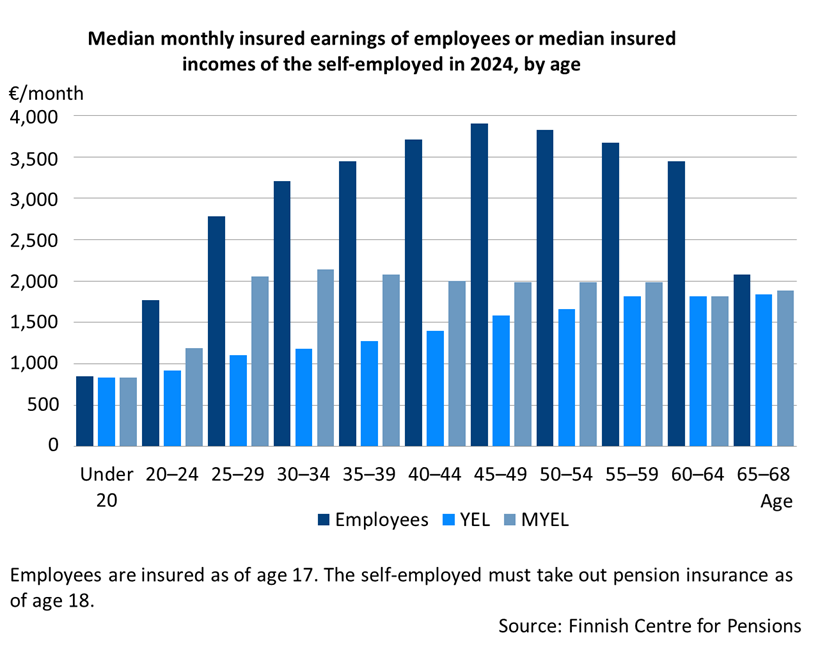Wages on the rise – young people face increasing barriers to entering the labour market

In 2024, employees’ median monthly earnings were 3,208 euros, an increase of 3.3 per cent from 2023. Despite this positive development in earnings, concerns remain over the difficulties young people are facing when trying to access the labour market. According to earnings statistics of the Finnish Centre for Pensions, the number of new employees covered by earnings-reated pension insurance has decreased around 10 per cent annually.
“Based on earnings-statistics of those with pension insurance, the earnings of Finns are developing favourably. Both average and median earnings increased by more than 3 per cent in 2024, so the real earnings increased by around 2 per cent. In 2023, the median earnings increased by more than 4 per cent”, says Statistics Planer Marjo Kaasila from the Finnish Centre for Pensions.
In 2024, the median monthly earnings for wage earners were 3,208 euros. The median monthly incomes of the self-employed insured under YEL was 1,494 euros. For those insured under MYEL, it was 1,987 euros.
Following income reviews conducted over the past two years, confirmed YEL-insured incomes have risen significantly. In 2024, the average monthly incomes of persons insured under YEL rose by 15 per cent. In 2023, they rose by 8 per cent. When reviewed by age group, the insured monthly earnings peak among 45–49-year-old employees. Their median monthly earnings were 3,902 euros in 2024.

“When reviewed by sector, the highest average wage levels are in central government, while the lowest are in municipalities and wellbeing services counties,” Kaasila adds.
In 2024, nearly 3 million people in Finland accrued earnings-related pensions based on earnings from work and incomes from self-employment. Of them, 2.7 million worked as employees and 286,000 as self-employed persons insured under YEL or MYEL.
Youth employment situation continues to deteriorate
Despite the generally positive trend in earnings, the outlook for young people in the labour market continues to worsen. In 2024, around 91,000 new individuals entered the earnings-related pension system – a figure 10 per cent lower than in 2023.
Most of the new people joining the earnings-related pension system are young, and some of them are immigrants. In 2024, more than half of the insured were under age 20 and nearly one fifth aged between 20 and 29.
The number of new insured individuals is strongly influenced by the economic climate.
“The labour market has been severely depressed, and a turnaround seems ever further away. The number of new insured has fallen by a tenth for the second year in a row. The change has been rapid; as recently as 2022, over 115,000 new individuals joined the earnings-related pension system,” notes Development Manager Jari Kannisto from the Finnish Centre for Pensions.
According to Statistics Finland, there were 843,000 people aged 17–29 in Finland in 2024. The proportion of this age group with pension insurance has slightly decreased over the past few years.
There were 760,000 insured persons under the age of 30, of whom 61 per cent were in employment at the end of 2024. This proportion has also dropped by a few percentage points over two years.
Pension accrual from uemployment periods for more than half a million Finns
The weak labour market is also reflected in the accrual of pension rights from periods of unemployment.
In 2024, unemployment benefits were paid to 574,400 people, 5 per cent more than in 2023.
Earnings-related pension accrues from periods during which earnings-related unemployment allowance is received, provided the person has earned pension through work beforehand.
Finnish Centre for Pensions’ statistics also account for irregular earnings
The statistics published by the Finnish Centre for Pensions are based on earnings insured for pension purposes, including all incomes covered by pension insurance, whether minor, irregular, or part-time. These insured earnings determine future pensions for Finns.
Statistics Finland also publishes wage structure statistics, which mainly cover full-time employees’ earnings. As minor earnings are excluded from wage structure statistics, the figures in those statistics tend to be somewhat higher than those based on pension-insured earnings.
Read more

